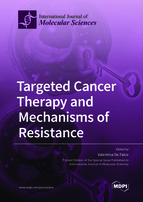Targeted Cancer Therapy and Mechanisms of Resistance
A special issue of International Journal of Molecular Sciences (ISSN 1422-0067). This special issue belongs to the section "Molecular Pathology, Diagnostics, and Therapeutics".
Deadline for manuscript submissions: closed (31 March 2021) | Viewed by 53065
Special Issue Editor
Interests: cancer; kinase inhibitor; target therapy; signal transduction; cell cycle; mitogenesis; survival; resistance
Special Issues, Collections and Topics in MDPI journals
Special Issue Information
Dear Colleagues,
Tumor cells commonly exhibit dependence on a single (often the initiating) activated oncogenic pathway or protein to maintain their malignant proliferation and survival, a phenomenon that is called “oncogene addiction”. According to this concept, protein kinases have been elected as promising molecular targets for cancer therapy. There are several possibilities to target these proteins in cancer, including monoclonal antibodies that can bind to the extracellular domain of the RTK, compounds able to favor the proteolytic degradation of the kinase and, finally, small molecule protein kinase inhibitors (PKIs). In addition to targeting oncogenes, new anticancer treatments have been increasingly developed towards tumor suppressor genes and RNA interference.
Despite promising results in cancer treatment with targeted cancer drugs, clinical experience has shown that only a fraction of patients respond to targeted therapies, even if their tumor expresses the altered target. This kind of resistance is known as primary resistance. Moreover, secondary or acquired resistance to the treatment arises almost invariably when tumors are treated with cancer drugs. Acquired resistance mechanisms can be divided into two main categories: 1) target-dependent and 2) target-independent mechanisms.
Target-dependent resistance typically occurs through genetic modifications of the target. Such genetic modifications may include point mutations and copy number amplifications. The acquisition of mutations conferring drug resistance has been documented for several PKIs, such as drugs against BCR/ABL, EGFR, FLT3, KIT and PDGFR. Evidence suggests mutation may pre-exist in a minority of cancer cells, and it is then selected upon treatment. This suggests that secondary PKI that can also bind the mutated kinase can be used to overcome resistance. Gene amplification is another major mechanism of target-dependent resistance. The selective pressure of the drug can drive amplification of the target gene, thus leading to additional overexpression of the encoded protein.
Instead, target-independent mechanisms occur through activation of alternative pathways that allow the bypass of the drug-mediated block. In other words, cancer cells escape treatment by switching to an alternative signaling pathway that is not inhibited by the drug.
Other mechanisms of resistance can exploit the enormous genome plasticity of cancer cells by modulating miRNA expression or remodeling chromatin. Finally, though not as commonly as with classical cytotoxic drugs, other resistance mechanisms can cause a decrease of the effective intracellular concentration of the targeted cancer drug.
Prof. Dr. Valentina De Falco
Guest Editor
Manuscript Submission Information
Manuscripts should be submitted online at www.mdpi.com by registering and logging in to this website. Once you are registered, click here to go to the submission form. Manuscripts can be submitted until the deadline. All submissions that pass pre-check are peer-reviewed. Accepted papers will be published continuously in the journal (as soon as accepted) and will be listed together on the special issue website. Research articles, review articles as well as short communications are invited. For planned papers, a title and short abstract (about 100 words) can be sent to the Editorial Office for announcement on this website.
Submitted manuscripts should not have been published previously, nor be under consideration for publication elsewhere (except conference proceedings papers). All manuscripts are thoroughly refereed through a single-blind peer-review process. A guide for authors and other relevant information for submission of manuscripts is available on the Instructions for Authors page. International Journal of Molecular Sciences is an international peer-reviewed open access semimonthly journal published by MDPI.
Please visit the Instructions for Authors page before submitting a manuscript. There is an Article Processing Charge (APC) for publication in this open access journal. For details about the APC please see here. Submitted papers should be well formatted and use good English. Authors may use MDPI's English editing service prior to publication or during author revisions.
Keywords
- cancer
- kinase inhibitors
- animal model
- cell culture
- drug resistance
- signal transduction
- survival
- cell reprogramming
- pathways
- clinical trials
- target therapy
- cancer heterogeneity
- stem cells
- immunity
- cell cycle
- cell death inhibiting
- survival
- biomarkers







